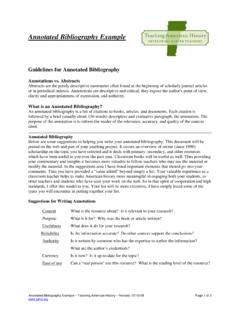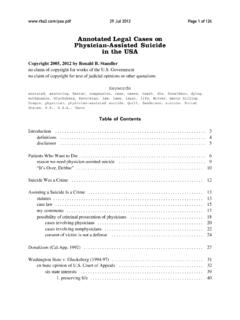Transcription of Annotated Bibliography on Leadership - McGonagill Consulting
1 McGonagill Associates 36 Highland Avenue, Suite 55 Cambridge, MA 02139 Tel (617) 714-5583 Fax (617) 714-5584 Email 2008 McGonagill Associates. All Rights Reserved. APPENDIX Annotated Bibliography on Leadership Annotated Bibliography on Leadership McGonagill Associates 36 Highland Avenue, Suite 55 Cambridge, MA 02139 Tel (617) 714-5583 Fax (617) 714-5584 Email 2008 McGonagill Associates. All Rights Reserved. TABLE OF CONTENTS Annotated Bibliography on Leadership Section A: The Four Clusters of Leadership Theory .. 2 1. Lead by Embodying the Right Personal Qualities .. 7 2. Lead by Doing the Right Things .. 20 3. Lead by Adapting What You Do to Fit the Situation .. 38 4. Lead by Selecting/Adapting the Situation to Fit You .. 42 Section B. Other Leadership Themes .. 48 1. Managing Your Shadow .. 49 2. Leadership by Phase of Engagement .. 58 3. Interpersonal/Influence/Negotiation Skills.
2 60 4. Leadership in the Middle 61 5. Leading Organizational Change .. 62 6. Portraits of Effective Leaders .. 63 7. Women and Leadership .. 64 8. Neuroscience and Leadership .. 65 9. The Ethics of Leadership .. 67 and Sustainability .. 69 Section C: Approaches to Leadership Development 1. Private Sector (and generic) .. 70 2. Public Sector .. 75 3. Non-Profit Sector .. 76 Section D: General References on Leadership .. 77 Annotated Bibliography on Leadership McGonagill Associates 36 Highland Avenue, Suite 55 Cambridge, MA 02139 Tel (617) 714-5583 Fax (617) 714-5584 Email 2008 McGonagill Associates. All Rights Reserved. SECTION A: The Four Clusters of Leadership Theory This section of the biblio-graphy is organized around four clusters of Leadership theory. Our view is that most theories of Leadership fit primarily into one of these clusters, each of which has strengths and limits.
3 However, an optimal approach to Leadership would draw on all four clusters. Annotated Bibliography on Leadership McGonagill Associates 36 Highland Avenue, Suite 55 Cambridge, MA 02139 Tel (617) 714-5583 Fax (617) 714-5584 Email 2008 McGonagill Associates. All Rights Reserved. SECTION A: The Four Clusters of Leadership Theory 1. Lead by Embodying the Right Personal Qualities. Overview The upper left Cluster focuses on the qualities that are thought to universally contribute to Leadership . It suggests that Leadership requires being the right kind of person, or at least having particular personal qualities. An early example is the Great Man theory of Leadership , which was popular at a time when only men were thought to be leaders. This was followed by a wave of trait theories that tried to specify the particular qualities that accounted for Leadership . An assumption in these earlier theories was that leaders are born, not made.
4 Interest in these early theories waned in 1930 s and 1940 s, as researchers were unable to agree on which qualities accounted for Leadership . However, the notion that the personal qualities of a leader are important has proved to have enduring value. There was a resurgence of theories emphasizing character in the 1980 s. You began to hear talk of transformational Leadership ( , Burns) and then charismatic Leadership ( , Conger). In this approach the leader s role is to help followers reach their full potential, raising their motivation and even their morality. The classic examples here are Mahatma Gandhi and Martin Luther King. Nelson Mandela would be another natural addition to the list. More recent versions of these theories place less emphasis on leaders being born and some assume that the desired qualities can be learned. But they tend to emphasize the larger than life character of leaders.
5 This has a downside. While it may be inspirational to review the contribution of people like political leaders like Gandhi, or corporate leaders such as Jack Welch, it could just as easily be disheartening. Such an emphasis implicitly discourages ordinary people from believing that they can rise to the Leadership challenge. A subtler limit is that even if one did find a correlation between Leadership and particular traits, it doesn t follow that having those traits leads to Leadership . Annotated Bibliography on Leadership McGonagill Associates 36 Highland Avenue, Suite 55 Cambridge, MA 02139 Tel (617) 714-5583 Fax (617) 714-5584 Email 2008 McGonagill Associates. All Rights Reserved. Nonetheless, the emphasis on a leader s character continues to attract rich contributions to advice on Leadership , and is the source of some of the most interesting recent contributions ( , Senge et al).
6 The value of this cluster for Leadership development is that it: Reinforces the importance of recognizing that your most valuable tool as a leader is yourself. Calls attention to the critical role of self knowledge, knowing your strengths and your limits. Makes clear the importance of developing yourself fully as a person ( , developing your emotional intelligence, your whole self ). Following are brief descriptions of some of the major examples of this 1 We are indebted to Arthur Jago for the basic idea of dividing Leadership theory into four parts, which we have adapted and extended (" Leadership : Perspectives in Theory and Research." Management Science 1982, 28(3): 315-336.) Annotated Bibliography on Leadership McGonagill Associates 36 Highland Avenue, Suite 55 Cambridge, MA 02139 Tel (617) 714-5583 Fax (617) 714-5584 Email 2008 McGonagill Associates.
7 All Rights Reserved. SECTION A: The Four Clusters of Leadership Theory 1. Lead by Embodying the Right Personal Qualities. Selected Examples Berens, Linda (2000). Understanding Yourself and Others: An Introduc-tion to Temperament. Huntington Beach, Calif.: Telos Publications. In this very useful booklet Berens provides a concise overview of temperament theory its history, nature and applications. This theory, created by David Keirsey (see below), provides a simple though not simplistic four-fold typology for understanding the ways in which people differ. Along with the MBTI, temperament offers one of the most useful of the many frameworks for understanding individual differences. Berens is a prot g of Keirsey and with him has been a strong advocate. She believes that Leadership style is directly related to who you are, which makes this work a good fit with the upper left cluster of theory.
8 However, unlike Keirsey, she does not believe that Temperament directly predicts one s approach to Leadership . Instead, it is a powerful way of understanding the differing basic orientations, including needs and values, that people typically bring to their Leadership roles. Boyatzis, Richard and Annie McKee (2005). Resonant Leadership : Renewing Yourself and Others with Mindfulness, Hope and Compassion. Cambridge, Mass.: Harvard Business School Press. This book reflects a trend in Leadership theory that points to the importance of developing one s character as a person in order to be an effective leader. As Daniel Goleman writes in the foreword, the first task in the challenge of knowing and managing oneself so that one can act in accord barometers This means connecting to one s values, aligning emotions with goals, and cultivating compassion as a way of lifting oneself out of self-preoccupation.
9 The authors provide suggestions for how to follow the advice of Gandhi to be the change you wish to see in the world. In doing so, they build on their previous work with Goleman, Primal Leadership , which underscored the importance emotional intelligence as a foundation for Leadership . A new dimension in this work is attention to how leaders lose resonance through the sacrifice syndrome, which results from an inability to manage prolonged stress, and results in dissonance rather than resonance. They offer an approach to coping with stress the cycle of sacrifice and renewal that is grounded in an recent research on brain chemistry, physiology, and positive psychology. It is a holistic approach, involving body, heart, mind and spirit. It requires inten-tional self development to cultivate mindfulness (aware of ourselves and the world around us), hope (belief that the future we envision is attainable) and compassion (understanding others wants and needs and feeling motivated to respond).
10 Annotated Bibliography on Leadership McGonagill Associates 36 Highland Avenue, Suite 55 Cambridge, MA 02139 Tel (617) 714-5583 Fax (617) 714-5584 Email 2008 McGonagill Associates. All Rights Reserved. Brill, Pam (2004). The Winner s Way: A Proven Method for Achieving Your Personal Best in Any Situation. New York: McGraw Hill. Psychologist Bill has created an original and illuminating synthesis of research and practice on how to be your best self. She organizes the book around a simple but compelling framework, the Three A s : Activation (the physical/physiological aspect of experience); attention (where you choose to focus); and attitude (guiding values, beliefs, and assumptions). Proper alignment of all three offers a path for staying in the zone, where peak performance is possible The book has a self- promotional tone, and using language with a good deal of hype. However, readers who are not put off by these stylistic features will be rewarded with a substantive and useful treatment of a proposition that is increasingly prominent in Leadership theory: the foundation for effective behavior (including Leadership ) is management of one s own consciousness.








![Abstract arXiv:1707.01836v1 [cs.CV] 6 Jul 2017](/cache/preview/4/1/7/c/3/c/f/5/thumb-417c3cf524207c81cbb20aac762ce5b4.jpg)